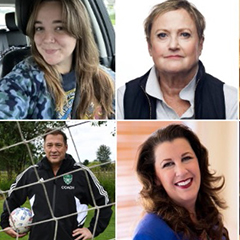CANCER CLINICAL TRIALS depend on enrolling people from different backgrounds so that the findings apply to anyone who might need treatment. But clinical trial participation has long been skewed.
At a special session during the 18th American Association for Cancer Research (AACR) Conference on The Science of Cancer Health Disparities, held Sept. 18 to 21, 2025, in Baltimore, presenters shared approaches to attract and connect more people to clinical trials. (The AACR publishes Cancer Today, and Cancer Today Editor-in-Chief William G. Nelson moderated the session.)
Despite ongoing efforts to expand participation across underrepresented racial, ethnic and socioeconomic populations, clinical trials still do not reflect the diverse makeup of the U.S. population. For example, people of color make up 42% of the U.S. population, but they account for 20% of clinical trial participants, said Nina Bickell, a physician and health equity researcher at the Mount Sinai Health System in New York City, in a presentation at the session. The lack of diverse enrollment in clinical trials limits people’s access to new treatments and reduces the generalizability of clinical trial findings. “If we want to make sure that we’re treating people with the best, most effective treatments, we need to ensure that, in fact, these treatments are effective for all individuals getting treated,” Bickell said.
Speakers at the session highlighted four programs supported by grants from Stand Up To Cancer that sought to broaden access to clinical trials.
Building Bridges
Early-phase clinical trials, which typically enroll a small group of participants and test the safety and appropriate dosages of treatments, often take place at large academic hospitals. However, many people in underserved areas receive their care at safety-net hospitals, which treat patients regardless of their ability to pay.
Public health researcher Linda Fleisher presented observations from the ADACT Initiative, which sought to increase collaboration between two Philadelphia institutions: Fox Chase Cancer Center, a National Cancer Institute-designated cancer center that regularly conducts cancer research and where Fleisher works, and Temple University Hospital, a safety-net hospital that serves an area with high levels of poverty and cancer mortality. Although only six miles apart and within the same health system, people who get care at Temple and don’t drive may need to take three buses to participate in a clinical trial at Fox Chase.
The ADACT Initiative established direct relationships between doctors at Temple University Hospital and Fox Chase. The doctors from each hospital collaborated to discuss patients and available trials, with the hope that they could identify potential matches.
Fleisher said the team needed to finetune the workflow to efficiently connect people getting care at Temple to clinical trials at Fox Chase. “I think the first patient that came through, it was 15 emails to 20 people, trying to make all these connections,” she said. But concerted efforts helped to make better collaboration possible.
In Los Angeles, researchers identified similar clinical trial barriers. People who were treated at public hospitals often weren’t aware of the clinical trials being offered at USC Norris Comprehensive Cancer Center, according to presenter Jennifer Tsui, a public health researcher at USC Norris. In addition, doctors at public hospitals had trouble getting responses to questions about enrollment. That delay could mean losing people who have reservations about participation, said Tsui.
Reaching Communities
Coordination between public and academic hospitals is essential to recruiting people who are historically underrepresented in clinical trials, but ultimately, research still depends on people choosing to participate.
In Dallas, researchers explored ways to connect people getting care at Parkland Hospital, a safety-net hospital, with trials at UT Southwestern Medical Center, an academic research institution. Before starting a trial, applying patients had to go through several logistical steps—including transferring medical records and getting approval for financial aid—that could be barriers to participation. Of the 55 people who were referred to the program, 15 successfully enrolled in early-phase trials, said Sukh Makhnoon, a public health researcher at UT Southwestern. In addition, joining a clinical trial meant spending additional time in medical appointments at a different facility. Makhnoon noted that, like the Los Angeles program, applying could also be a long process, in one case lasting 76 days between submitting an application and starting the treatment.
Bickell discussed a program introduced in New York City called DISRUPT, which stands for Diversity and Inclusion in Research Underpinning Trials. DISRUPT, she said, attempted to flip the typical recruiting model by focusing on patients. Every week, participating care centers used an algorithm to match the people coming in for appointments with clinical trials they could be eligible for.
The DISRUPT researchers found that, while there are more opportunities to join a trial when cancer progresses, it is a difficult time to introduce people to clinical research as a treatment option. “Many patients are really overwhelmed at this point in time and don’t even want to think about a clinical trial,” Bickell said. “And that really raises one of the important lessons learned. It’s so important to normalize the idea of clinical trials early on, before they’re actually necessary, so it doesn’t catch patients off guard.”
DISRUPT has partnered with artists and filmmakers to raise awareness about clinical trials long before people are approached to participate in one. Bickell said future research should explore how to lay that groundwork earlier in care so patients can view clinical trials as an option from the start—not as a last resort.
Though many people blame historical abuses for hesitation among Black people and other minority groups to join clinical trials, Bickell said people she spoke to through DISRUPT noted that their decisions were formed by personal interactions with doctors and researchers. “One of the biggest things we keep hearing out in the community about why people don’t want to participate in clinical research is because of their own experiences,” Bickell said. “It really boils down to not being treated well by the health care system.”
Cancer Today magazine is free to cancer patients, survivors and caregivers who live in the U.S. Subscribe here to receive four issues per year.





